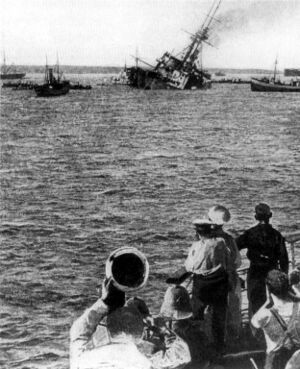Battle of the Asur
| Battle of the Azur | |||||||
|---|---|---|---|---|---|---|---|
| Part of the Great War (Aeia) | |||||||
 The last moments of Midrasian ship Courage, torpedoed by B-33 on 12th January 1896 | |||||||
| |||||||
| Belligerents | |||||||
|
|
| ||||||
| Commanders and leaders | |||||||
|
|
| ||||||
| Strength | |||||||
| ????? | ???? | ||||||
| Casualties and losses | |||||||
| TBD | TBD | ||||||
The Battle of the Azur was the longest continuous military campaign in First Great War, running from the outbreak of the war in 1895 to the defeat of the Veleazan Empire in mid-1899, and played a major role in the development of modern naval tactics. At its core was the Allied naval blockade of Veleaz, announced the day after the declaration of war, and Veleaz's subsequent attempts to break out. The battle reached it's height in 1897.
The Battle of the Azur pitted the submarines and other warships of the Veleazan Armada against the Republican Navy of Midrasia and Allied merchant shipping. These clashes marked the first time that large, industrial fleets consisting largely of battleships would meet. However, much of the war consisted of Veleazan raids in allied merchant vessels, coming mainly from the colonial territories of allied nations and predominantly going to the Midrasia, which were protected for the most part by the Allied navies, especially ships of blockaded nations that had been outside of their home ports at the outbreak of the war.
As much of its farming regions were situated close to the frontlines of the Northern Front and Southern Front, Midrasia became highly dependent on imported goods from it's colonial territories. Midrasia required more than a million tons of imported material per week in order to be able to survive and fight. Following a botched attempt to take control of the Azur island, the Battle of the Azur turned into tonnage war: the Allied struggle to supply the fight and the Concordat's attempt to stem the flow of merchant shipping that enabled them to continue fighting. From 1942 onward, the Axis also sought to prevent the build-up of Allied supplies and equipment in Midrasia and Romellea, inf ear that a large scale operation would be launched. The defeat of the submarine threat was a prerequisite for pushing back the Concordat, while the submarine war became the focus of the Concordat, due to the Veleazan fleet being held in port. The outcome of the battle was a strategic victory for the Allies, with the virtual annihilation of the Veleazan Fleet at the Action of 1899.
The Battle of the Azur has been called the "longest, largest, and most complex" naval battle in history. The campaign started immediately after the War began and lasted four years, until the Veleazan Surrender in June 1899. It involved thousands of ships in more than 100 battles and perhaps 1,000 single-ship encounters, in a theatre covering thousands of square miles of sea. The situation changed constantly, with one side or the other gaining advantage, as participating countries surrendered, joined and even changed sides in the war, and as new weapons, tactics, counter-measures and equipment were developed by both sides. The Allies gradually gained the upper hand, overcoming Veleazan fleet by the beginning of 1899, though the submarine threat continued on till the surrender of Veleaz in mid-1899.